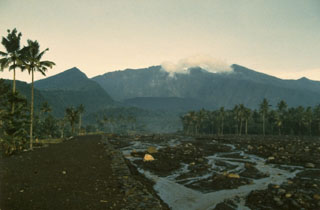Report on Galunggung (Indonesia) — February 1984
Scientific Event Alert Network Bulletin, vol. 9, no. 2 (February 1984)
Managing Editor: Lindsay McClelland.
Galunggung (Indonesia) Small phreatic explosion
Please cite this report as:
Global Volcanism Program, 1984. Report on Galunggung (Indonesia) (McClelland, L., ed.). Scientific Event Alert Network Bulletin, 9:2. Smithsonian Institution. https://doi.org/10.5479/si.GVP.SEAN198402-263140
Galunggung
Indonesia
7.25°S, 108.058°E; summit elev. 2168 m
All times are local (unless otherwise noted)
A phreatic explosion 9 January produced a cloud that was mostly steam with a little ash. Steam emission remained more vigorous than usual for about two days. Local volcanic tremor accompanied the activity but no significant increase in deeper seismicity was noted before or during the increased steam emission. Explosive activity was also reported 31 January but no details were available from the ground and weather clouds prevented satellite observations.
Explosive activity stopped after extrusion of a small lava flow onto the crater floor in early January 1983.
Further References. Hanstrum, B.N., and Watson, A.S., 1983, Case study of two eruptions of Mount Galunggung and an investigation of volcanic eruption cloud characteristics using remote sensing techniques: Australian Meteorological Magazine, v. 31, p. 171-177.
Sawada, Y., 1987, Study on analysis of volcanic eruption cloud image data obtained by the Geostationary Meteorological Satellite (GMS): Technical Reports of the Meteorological Research Institute (Japan), no. 22, 335 p..
Geological Summary. The forested slopes of Galunggung in western Java SE of Bandung are cut by a 2-km-wide collapse scarp open towards the ESE. The "Ten Thousand Hills of Tasikmalaya" dotting the plain below the volcano are debris-avalanche hummocks from the collapse about 4,200 years ago. An eruption in 1822 produced pyroclastic flows and lahars that killed over 4,000 people. A series of major explosive eruptions starting in April 1982 destroyed a number of villages, killed as many as 30 people, and forced over 60,000 to evacuate. Pyroclastic flows and heavy widespread ash caused significant damage. A large passenger jet that encountered the ash plume on 24 June lost power to all four engines but managed to land safely in Jakarta. The 1982 activity destroyed a 1918 dome and formed the Warirang crater, almost as wide as the valley, about 2 km down from the summit.
Information Contacts: A. Sudradjat, VSI; W. Smith, FAA.

